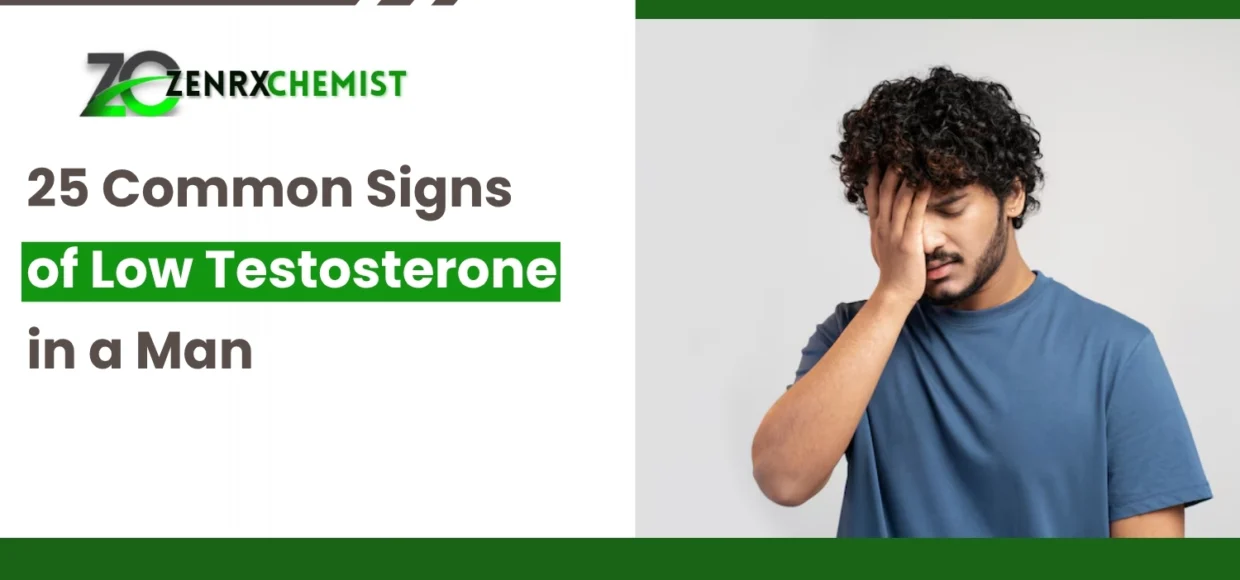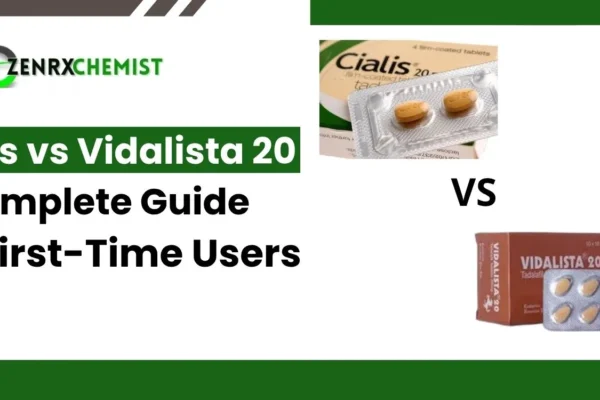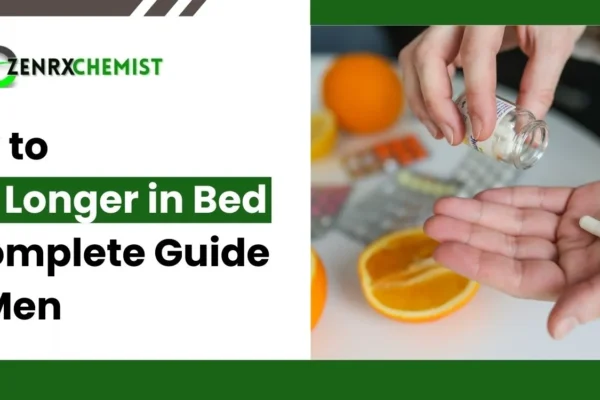Blog
25 Common Signs of Low Testosterone in a Man
Introduction
Testosterone is the primary androgenic hormone in males, playing a central role in sexual development, reproductive function, muscle mass regulation, bone density, and mood stabilization. Produced primarily by the testes and regulated by the hypothalamic-pituitary-gonadal axis, its levels peak in adolescence and slowly decline with age. Understanding the clinical signs of a deficiency is critical to early detection and effective management.
What Is Considered Low Testosterone?
Low testosterone—clinically termed hypogonadism—is generally diagnosed when total testosterone levels fall below 300 ng/dL. However, symptom severity doesn’t always correlate with blood levels. Many men may experience symptomatic decline even at levels within the lower end of the “normal” range, often requiring clinical context and confirmatory testing for accurate diagnosis.
25 Common Signs of Low Testosterone in Men
Decreased Libido
A significant reduction in sexual desire is one of the earliest and most common indicators. This occurs due to testosterone’s direct influence on the hypothalamus and sexual motivation pathways.
Erectile Dysfunction
Testosterone supports nitric oxide synthesis, essential for penile blood flow. Lower levels impair this mechanism, making it harder to initiate or maintain an erection, even in the presence of adequate arousal.
Fatigue and Low Energy
Men with low T frequently report persistent fatigue, regardless of rest or sleep. Testosterone affects mitochondrial efficiency, which is key for cellular energy production and overall stamina.
Loss of Muscle Mass
Anabolic effects of testosterone help maintain muscle protein synthesis. A drop in hormone levels reduces lean body mass and muscle tone, particularly noticeable in arms, legs, and chest.
Increased Body Fat
Decreased testosterone leads to a shift in body composition, often resulting in increased visceral and subcutaneous fat—especially around the abdomen—due to altered metabolism and estrogen conversion.
Depression and Mood Changes
Testosterone impacts neurotransmitters like serotonin and dopamine. Deficiency is associated with irritability, low mood, reduced motivation, and in some cases, clinical depression.
Memory and Cognitive Fog
Cognitive decline, especially in working memory and executive function, may be tied to low testosterone. Some men report difficulty focusing or experiencing a persistent “mental fog.”
Decreased Bone Density
Testosterone is vital for bone remodeling. Chronic deficiency increases the risk of osteopenia and osteoporosis, especially in men over 50.
Sleep Disturbances
Men with low testosterone often report insomnia or fragmented sleep. This is due to its role in regulating sleep architecture, especially REM cycles.
Reduced Testicle Size
Hypogonadism can lead to testicular atrophy, where the testicles become noticeably smaller due to reduced stimulation of Sertoli and Leydig cells.
Hot Flashes and Night Sweats
Although more common in women, men with severe testosterone deficiency may experience vasomotor instability, leading to sudden sensations of heat or excessive sweating.
Low Sperm Count and Infertility
Testosterone supports spermatogenesis. A drop in intratesticular testosterone may result in reduced sperm production and quality, impacting fertility.
Reduced Beard and Body Hair Growth
Testosterone stimulates hair follicles during puberty. A noticeable thinning of facial, chest, or leg hair in adulthood may signal hormonal insufficiency.
Gynecomastia (Male Breast Tissue Development)
Hormonal imbalance between testosterone and estrogen can lead to glandular breast tissue growth, resulting in discomfort or visible swelling in the chest area.
Increased Irritability or Anger
Men with low testosterone may report shorter tempers, impulsiveness, or a low frustration threshold due to changes in neurotransmitter sensitivity.
Poor Workout Recovery
Muscle recovery post-exercise is slower due to impaired protein synthesis and increased muscle breakdown, which testosterone usually helps prevent.
Loss of Morning Erections
Spontaneous morning erections are influenced by testosterone. Their absence over time may reflect an underlying endocrine issue.
Decreased Motivation or Drive
Low testosterone can reduce dopamine levels, which in turn affects ambition, personal drive, and interest in hobbies or career.
Dry Skin or Skin Thinning
Testosterone contributes to skin thickness and collagen support. Men with low levels may report dry, thin, or fragile skin.
Anemia
Testosterone stimulates erythropoiesis in the bone marrow. Low levels can lead to mild to moderate anemia, often reflected in chronic tiredness and pale skin.
Difficulty Building Muscle Despite Training
Even with consistent resistance training, men may notice that muscle mass gains are minimal due to impaired anabolic signaling.
Lower Pain Threshold
Some men report heightened sensitivity to pain or discomfort, possibly linked to the hormone’s modulation of pain perception.
Poor Circulation and Cold Sensitivity
Reduced testosterone levels can affect vascular tone, sometimes resulting in cold extremities or slower wound healing.
Voice Changes
Though rare, significant long-term deficiency might soften the male vocal tone slightly due to reduced laryngeal muscle strength.
Lower Self-Esteem or Confidence
The cumulative effect of low libido, fatigue, mood shifts, and physical changes often impacts a man’s self-worth and interpersonal confidence.
Causes of Low Testosterone Levels
Low testosterone may result from primary causes (testicular dysfunction), secondary causes (hypothalamic or pituitary issues), or external factors such as obesity, chronic illness, alcoholism, or prolonged stress. Certain medications, such as corticosteroids and opioids, may also suppress testosterone synthesis.
How Is Low Testosterone Diagnosed?
Diagnosis typically involves measuring total and free testosterone through blood tests, preferably in the morning when levels are highest. It may also require luteinizing hormone (LH), follicle-stimulating hormone (FSH), and prolactin testing to determine the source of dysfunction. A comprehensive evaluation ensures correct interpretation and targeted treatment.
Potential Risks and Complications
Untreated low testosterone can increase the risk of cardiovascular disease, type 2 diabetes, reduced quality of life, osteoporosis, and infertility. Early intervention helps mitigate these long-term risks, especially in younger or middle-aged men.
Is Low Testosterone Always a Problem?
Not always. Mild age-related testosterone decline may not require intervention unless symptoms affect quality of life. Treatment decisions should be based on symptom severity, lab results, and patient goals, rather than numerical thresholds alone.
Which Doctor to Consult for Low Testosterone
Men experiencing signs of low testosterone should consult an endocrinologist or a urologist. In many cases, a general physician can conduct initial assessments and refer to a specialist if hormone therapy or further endocrine evaluation is needed.
Conclusion
Low testosterone affects many aspects of male health—physically, mentally, and emotionally. Recognizing early signs can lead to timely intervention and improved outcomes. Clinical diagnosis and tailored management, including lifestyle changes and hormone therapy when appropriate, are essential for maintaining long-term well-being.
FAQs About Low Testosterone in Men
Q1: Can low testosterone be reversed naturally?
Yes, in some cases. Lifestyle changes like weight loss, better sleep, and resistance training can help raise levels.
Q2: Is testosterone replacement therapy (TRT) safe?
TRT can be safe under medical supervision, but it may carry risks and should be prescribed only after proper diagnosis.
Q3: Can low testosterone affect fertility?
Yes. It may lead to reduced sperm count and quality, especially if untreated.
Q4: What is the normal testosterone level for adult men?
Typically between 300–1,000 ng/dL, but optimal levels vary based on age and individual health.
Q5: Does low testosterone mean a man is not masculine?
Not at all. Hormone levels do not determine masculinity. Low T is a medical condition, not a personality trait.







